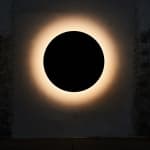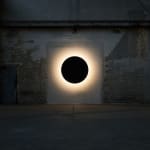Felix Kiessling
Further images
-
(View a larger image of thumbnail 1
)

-
(View a larger image of thumbnail 2
)

-
(View a larger image of thumbnail 3
)

-
(View a larger image of thumbnail 4
)

-
(View a larger image of thumbnail 5
)

-
(View a larger image of thumbnail 6
)

-
(View a larger image of thumbnail 7
)

-
(View a larger image of thumbnail 8
)

Colourful Sonnen operate through an excess of visibility. Each monochromatic circle radiates outward, the pigment vibrating beyond its surface, creating halos that blur the line between object and phenomenon. These works heighten perception by saturating it: they are about color as energy, expansion, and presence.
The Antisonne inverts this logic. Instead of light, it offers its negation. A black disk, coated with light-absorbing pigment and set against an illuminated wall, it refuses to reflect, refuses to glow. Rather than extending into the room, it collapses into itself, generating the impression of an aperture, a blind spot, an impossible void. It does not reveal, but conceals. It does not project, but absorbs.
Standing before it, viewers encounter a paradox: the Antisonne is palpably present, large, physical, within reach, yet it resists being seen as an object. It denies scale, depth, materiality. The eye falters, orientation slips, and one feels drawn into an immaterial depth that cannot be fathomed. This destabilization is not accidental but essential: for Kiessling, such moments of perceptual failure are opportunities to glimpse reality less conditioned by habit, expectation, and representation.
In dialogue with the radiant suns, the Antisonne defines the opposite pole of the same inquiry. If the Sonnen reveal perception through saturation, the Antisonne does so through negation. Together, they form a dialectical pair, expansion and collapse, glow and void, immersion and disorientation. Both insist that perception itself, not representation, is the true subject.
The Antisonne is thus not just a black circle. It is the counter-sun, a threshold into absence, a work that turns the act of looking against itself in order to reveal its fragility. Where the colourful suns celebrate the fullness of vision, the Antisonne makes us aware of the voids within it.







